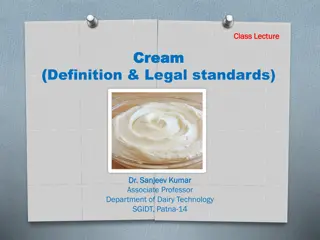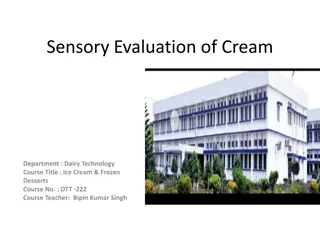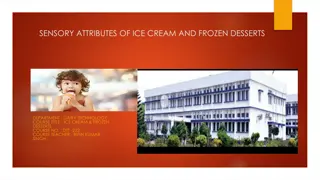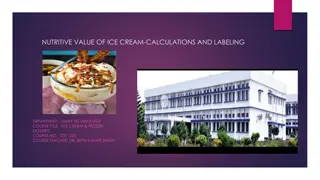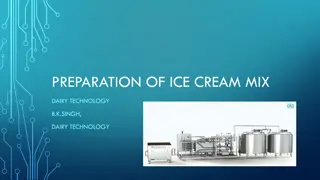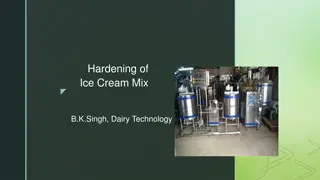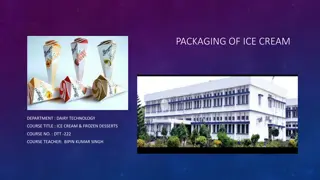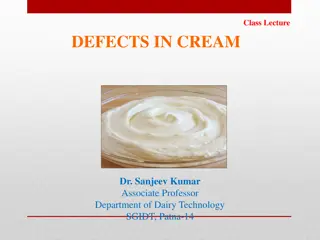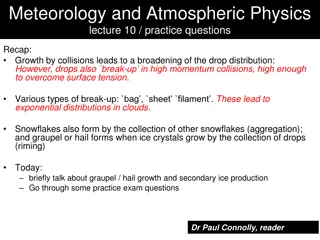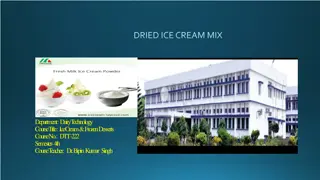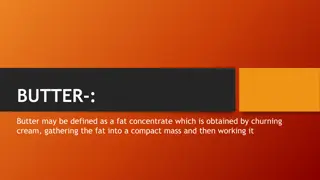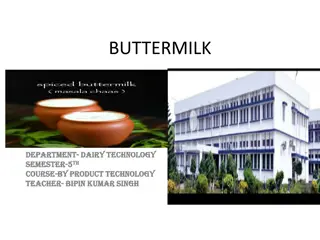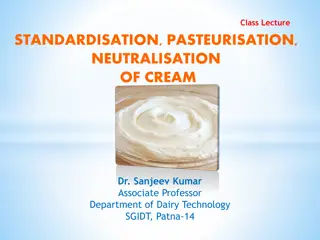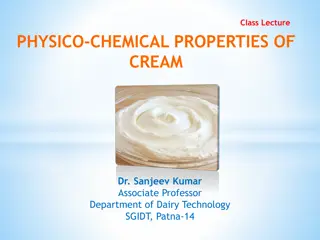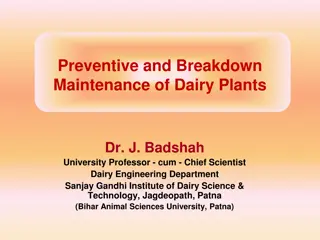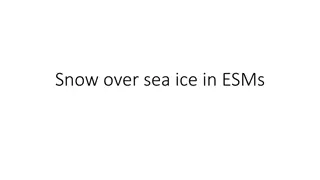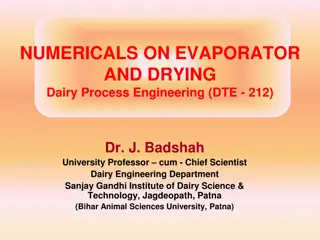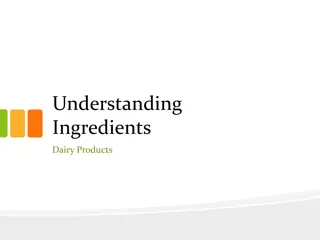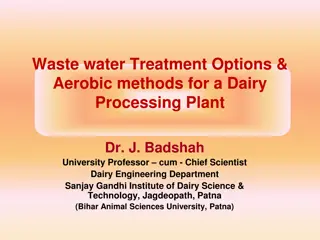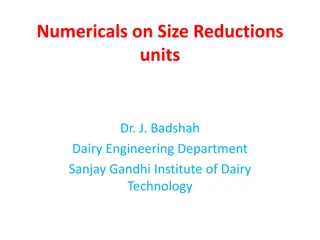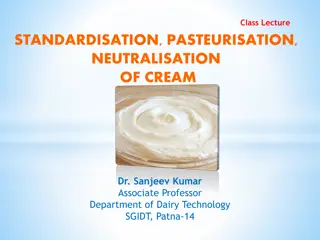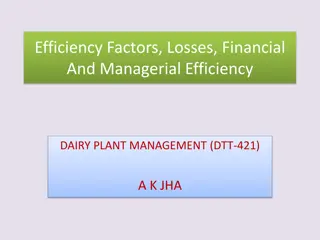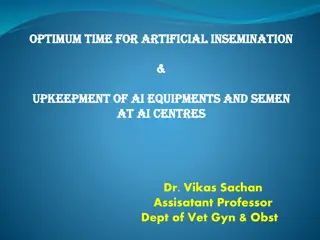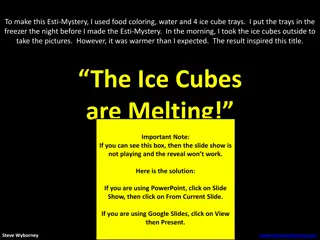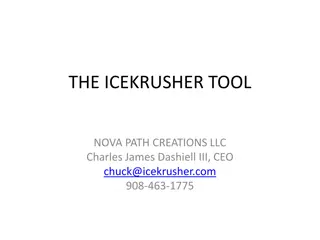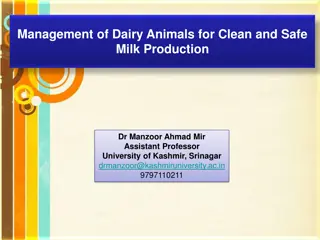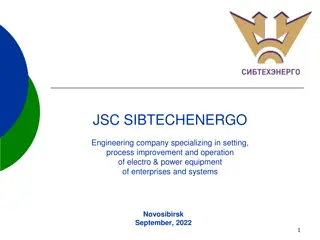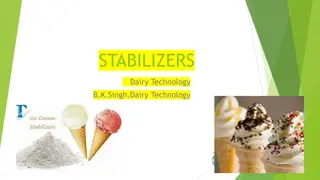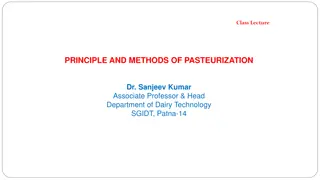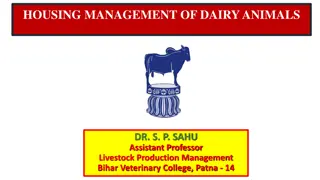Ice Cream Making Equipment and Processes in Dairy Engineering
Manufacture of ice cream involves the use of various equipment and precise processes to achieve a smooth and creamy final product. Key steps include freezing the mix, incorporating air for proper overrun, and maintaining specific temperatures throughout. Batch freezers and continuous freezers play vital roles in the ice cream production process, ensuring the desired texture and quality are achieved. The flow diagram illustrates the sequential steps involved in ice cream production, from raw materials to hardening and storage.
Download Presentation

Please find below an Image/Link to download the presentation.
The content on the website is provided AS IS for your information and personal use only. It may not be sold, licensed, or shared on other websites without obtaining consent from the author. Download presentation by click this link. If you encounter any issues during the download, it is possible that the publisher has removed the file from their server.
E N D
Presentation Transcript
ICECREAM MAKING EQUIPMENTS Dairy Process Engineering (DTE- 212) Dr. J. Badshah Head, Dairy Engineering, SGIDT, Patna (Bihar Animal Sciences University, Patna)
MANUFACTURE OF ICE-CREAM Function of the Freezer a. To freeze a portion of the water of the mix to get a smooth product, b. To incorporate a predetermined amount of air uniformly into the mix to get proper overrun. Principle of Freezing a. Fast freezing is essential for a smooth product because ice crystals that are formed quickly are smaller than those formed slowly. achieved by efficient scrapping off, large temperature gradient, High Rpm of scraper and dasher, high overall heat transfer coefficient. Therefore, it is desirable to freeze and draw from the freezer in short residence time b. Failure to provide adequate refrigeration during freezing or hardening, results in formation of large ice-crystals in ice cream. It is desirable to freeze the ice cream as stiff as possible in freezer to avoid the slow freezing and large crystal formation during hardening. c. In Batch freezer air incorporation and absorption is better upto 24 F and below this, the ice cream becomes very stiff and absorption of air becomes slower. d. In continuous freezer the air incorporation under pressure above atmospheric pressure is greatly increased at low temperature of freezing. This is
Flow Diagram of Manufacture of Ice Cream Raw materials Aging of mix Weighing and blending Addition of Flavour Filtration Partial Freezing of Mix in Freezer ( Incorporation of air, 150-250 rpm and - 5 C in 6 to 8 min. in batch freezer and 100 to 150 rpm and -20 to -30 C in 30 sec. for partial freezing) Pasteurization(80 C for 15 sec or 66 C for 30 minutes) Homogenization (175 -210 and 40 kgf/cm2,below 2 micron) Wrapping and Cartoning Cooling ( 4 C, 6 to 9 hr for mix with gelatin and 1 -2 hr for mix containing sodium alginate) Hardening in Hardening room Cold Store
Horizontal batch freezer It has refrigerated drum or cylinder which is stationary, with direct expansion of refrigerant in the coils surrounding the cylinder. The cylinder itself can be of SS or Brass with Nickel coating The cylinder has a front door to be opened, which in its inner side has bush arrangement to hold a horizontal shaft. The door even when closed, the cylinder has an opening at the top to pour ice cream mix, and another opening at bottom to draw frozen ice cream. Dasher which is a combination of Beater and Scrapper has the following functions: i. To scrape the frozen film from cylinder wall,so that ice crystals do not grow beyond 40 ii. Beat the mix to incorporate air to the maximum extent possible iii. Mix any fruit & flavouring material uniformly iv. Eject the finished ice cream rapidly v. It is important to have the dasher in proper alignment and the blades must be sharp. vi. The beater and scrapper rotate in opposite direction to avoid slug type movement of the entire semi-frozen mix. vii. The Dasher rpm is usually 150 to 250.
Continuous Ice-Cream Freezer The volume of the cylinder is comparatively reduced, by having more solid dasher and mix passing as a thinner layer,as compared to batch process. The freezing chamber is supplied with mix from tank by two pumps in some designs, where the first pump is a metering pump, designed to feed mix at a controlled rate.The outlet of this pump leads to a second pump through a pipe, which has provision to allow controlled quantity of air. The second pump being larger in capacity (approx. three times), it handles both incoming air and the mix. The second pump, then, leads the mixture of air and ice cream mix, in to the freezing chamber at about 5 to 6 kg/ cm2.
Continuous Ice-Cream Freezer Other designs single large pump with air entry on suction along with mix. Both horizontal and vertical models are available. In a continuous freezer, about 30 second time is taken for partial freezing the mix. The ice crystal size is reduced to 45-55 m and the air cell wall thickness to 100-150 m. For cooling, evaporating coolants in the temperature range of -20 to -30 C are used in the cooling jacket.
Pumps in continuous Freezer Pumps of ice-cream freezers are usually of the rotary type with the capability to pump against pressure of 7-14 kg/cm2(690-1380 kPa) with reasonable volumetric efficiency. There are two general pumping arrangements, both designed as a part of the overrun system. The first employ to pump or meter the mix into the freezing cylinder. The outlet of this pump leads to a second pump through a pipe,which has provision to allow controlled quantity of air plus it has a hold-back valve at the ice cream discharge port.The hold- back valve may be spring loaded with manual adjustment, it may have an air operator with adjustable air pressure supplying the operating power.The hold-back valve permits imposing a pressure on the cylinder during freezing which compresses the air admitted with the mix for overrun. Cylinder pressure of 3.5-4.0 atmospheres keeps the volume of air in the freezing cylinder sufficiently small so that it does not significantly lower the internal heat transfer out from and through the mix.
Controls and Automation in Freezer On-off switches for pump and dasher motors and for air compressor motors Switch for solenoid valves on hot gas defrost lines, air lines and refrigerant supply lines,speed regulation of pumps, Refrigeration supply and back pressure control valves Pressure gauges for the refrigeration system and cylinder or air pressure and Dasher motor ammeter,wattmeter or motor load indicator. A viscosity meter and controller, and a programmable controller or micro-processor to operate and control most functions of the ice cream freezer. The modern ice cream freezers equipped with a micro-processor programmed to control all the function of operation including overrun, viscosity of product, cylinder pressure, all operating steps such as start up, routine or emergency shutdown, resumption of operation after an automatic shutdown when the reason for shutdown has been corrected.


